Timeline
For PCS-1457
1943 to 1950
|
USS John Blish |
The U.S.S. John Blish




|
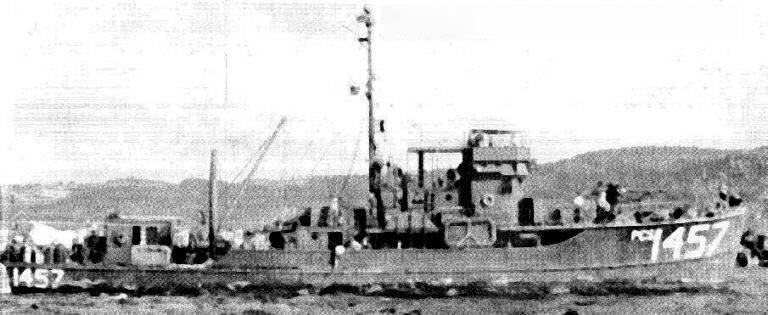
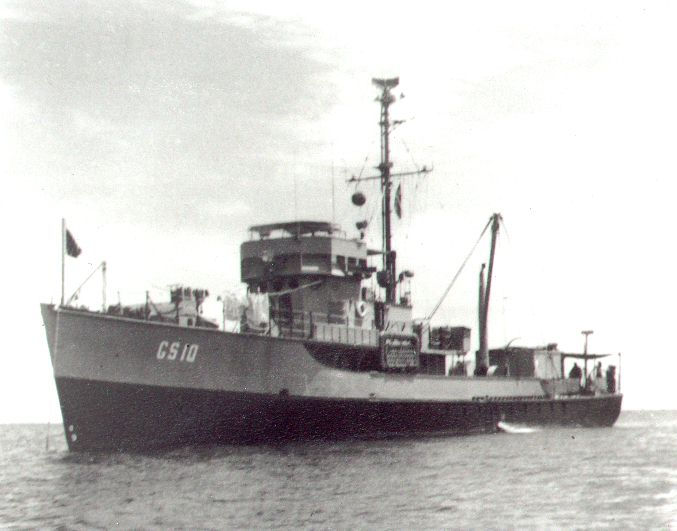
AGS-10, now the USS John Blish
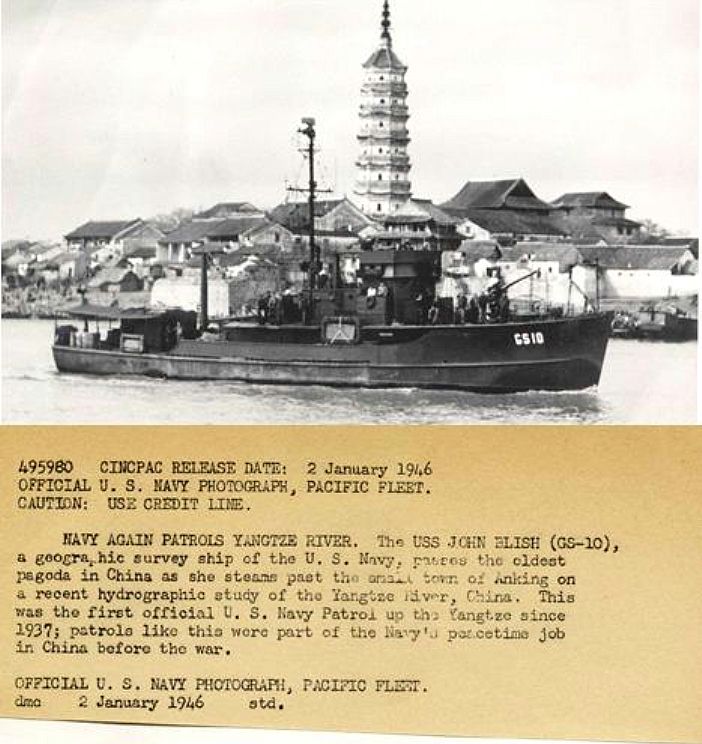
AGS-10, now the USS John Blish, on the Yangtze River
PCS-1457 was reclassified as a Hydrographic Survey Ship designated AGS-10 on March 20th, 1944, and named the USS John Blish on March 23rd, 1944, in honor of US Naval Commander John Bell Blish. The ship was commissioned February 26th, 1944. In her final role, she was recommissioned AGSc-10 (the small "c" adds the designation "coastal", so AGSc is "Hydrographic Survey Ship, Coastal.")
A PCS vessel is a "Patrol Craft, Sweeper". The US Navy took delivery of 59 of these small ships. They are also known by many as "Submarine Chasers" however there are actually naval ships of this designation (SC) and so that designation isn't technically correct, though that was indeed the precise service that these ships were designed to perform.
The USS John Blish was a very small wooden hulled ocean-going vessel. She was 136 feet in length, 23'4 on the beam, with an 8'7 draft. Diesel driven, by two 900 hp diesels, propulsion being provided by twin screws, one shaft per engine. Her top rated speed was 14.5 knots, with an economical cruise speed of 10 knots. Her range was 3,000 nautical miles at 12 knots. She displaced 245 to 251 tons. The ship was designed for 58 crew. The ship was armed with 1 3"/50 DP, 1 40mm gun, 4 20mm guns and 6 600 lb depth charges.
As a small ship, the USS John Blish had few amenities, and delivered quite a rough ride on the high seas. A former USS John Blish crewmember, Jim Bloodworth, recalls:
When we came alongside large ships to take on supplies, our regular question to men on the large ship was "How is that shore duty?"
The USS John Blish served in world war II beginning in the spring of 1944, and saw action as a submarine chaser, a minesweeper and an oceanographic survey vessel during the invasions of Iwo Jima and Okinawa. She also provided support for U.S. operations in the Marianas, assisting in the major offensives on the strategic bases of Guam and Tinian. As a survey vessel (redesignated AGS-10), she performed hydrographic duties in the Pacific.
 She also was present for two nuclear weapons tests at the Bikini Atolls. Prior to the tests, the ship had ballast added to the keel at the captain's recommendation in order to increase the ship's stability in rough waters. The change was made at Bremerton, Washington. The ship was then assigned to take tests of the ocean floor, obtaining samples and other data from the waters and seabeds in and around the Bikini Isles. One way this was done was with a small A-Frame hoist which was erected on the fantail. A section of pipe with traps and weights was then dropped. After hitting bottom, the traps closed, and a sample of the floor and water was brought aboard.
She also was present for two nuclear weapons tests at the Bikini Atolls. Prior to the tests, the ship had ballast added to the keel at the captain's recommendation in order to increase the ship's stability in rough waters. The change was made at Bremerton, Washington. The ship was then assigned to take tests of the ocean floor, obtaining samples and other data from the waters and seabeds in and around the Bikini Isles. One way this was done was with a small A-Frame hoist which was erected on the fantail. A section of pipe with traps and weights was then dropped. After hitting bottom, the traps closed, and a sample of the floor and water was brought aboard.
Three scientists from the Smithsonian Institution in Washington, D.C. were aboard ship and were in charge of the testing and records. This was very extensive in and around the lagoon. This was done before and after the Able and Baker tests.
On the day of the Able test the ship was 12 miles from Ground Zero. Personnel were required to look away from the direction of the blast. For the Baker test the ship was reportedly 15 miles away.
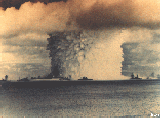 After the Baker test, all personnel were tested for radiation aboard ship; the gear aboard ship was also tested. Shoes and some clothing were destroyed because of contamination. The Captains Gig (a boat about 18' long) was put adrift and sank using 50mm AA because it was also contaminated; they also burned the coxswain's clothes prior to leaving the area because they were contaminated.
After the Baker test, all personnel were tested for radiation aboard ship; the gear aboard ship was also tested. Shoes and some clothing were destroyed because of contamination. The Captains Gig (a boat about 18' long) was put adrift and sank using 50mm AA because it was also contaminated; they also burned the coxswain's clothes prior to leaving the area because they were contaminated.
After the ship's tasks were completed subsequent to the Baker test, The USS John Blish returned to Pearl Harbor. The trip home was not uneventful; on the way, one of the ship's two engines failed in such a way as to be unable to run forward. The ship limped back to Pearl Harbor on one engine. Upon arrival, repair of the engine was delayed because the engine was measurably radioactive. Dave Jacobs, a seaman on the trip, states: "When they put the geiger counter on the engines the geiger counter almost exploded."
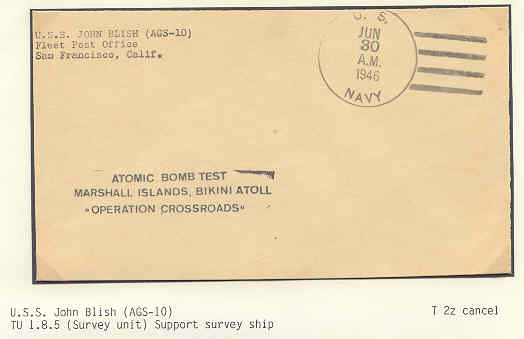
The following were known to have been on board the USS John Blish during the atomic tests:
The USS John Blish was assigned to Joint Task Force 1, task Group 8, the service group for the nuclear test series. The subunit was 5, so we have TU 1.8.5, a survey unit. The members of that subunit were:
The ship returned to San Francisco in October, and it was then assigned to other duties, generally providing hydrographic data for the regions off the west coast of the United States during her three year active postwar period. She was reclassified to reflect this role as AGSc--10 on July 27th, 1946.
"AG" vessels are "Miscellaneous Auxiliaries", and "AGS" vessels are survey ships. There were four conversions in total of PCS-class vessels to AGS-class vessels, of which PCS-1457, the USS John Blish, was one.
Finally, she sailed to New York in 1948, and was decommissioned there August 26th, 1949. The ship was stricken from the navy's lists and sold for scrapping to the Boston Metals Company, Baltimore, Maryland on February 10th, 1950.




The USS John Blish received four battle stars for World War II service.
|
Ultra-rare footage of an SC-class ship under way after WWII. This ship has a very similar profile to a PC-class. I'm still looking for footage of a PC-class! From the library of Charles B. Blish |